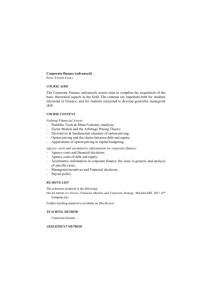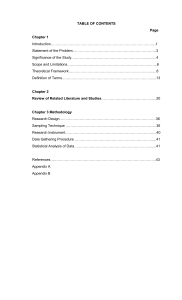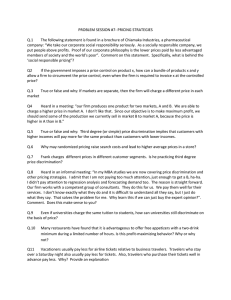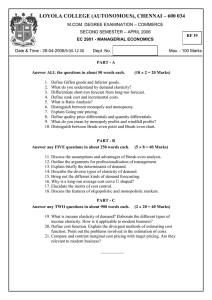Managerial Economics Textbook: Economic Tools for Decision Makers
advertisement
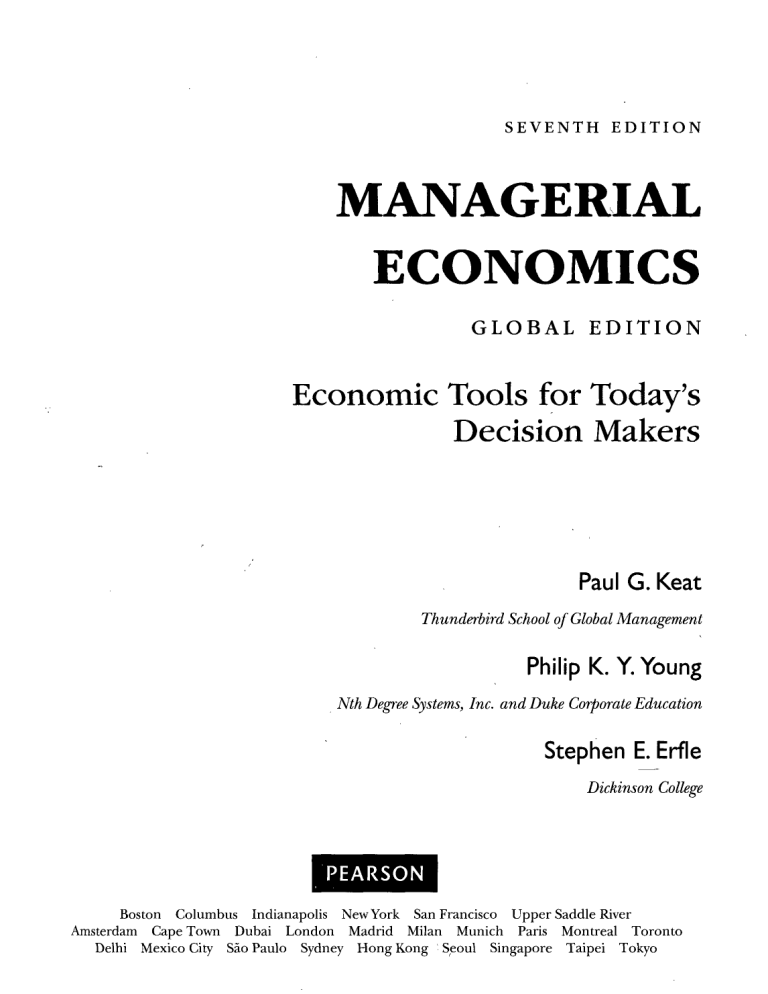
SEVENTH EDITION MANAGERIAL ECONOMICS GLOBAL EDITION Economic Tools for Today's Decision Makers Paul G. Keat Thunderbird School of Global Management Philip K. Y. Young Nth Degree Systems, Inc. and Duke Corporate Education Stephen E. Erfle Dickinson College PEARSON Boston Columbus Indianapolis New York San Francisco Upper Saddle River Amsterdam Cape Town Dubai London Madrid Milan Munich Paris Montreal Toronto Delhi Mexico City Sao Paulo Sydney Hong Kong Seoul Singapore Taipei Tokyo Contents Preface 19 About the Authors *• 25 CHAPTER 1 Introduction 27 Introduction: Economics and Managerial Decision Making 28 A Brief Review of Important Economic Terms and Concepts 31 The Case of Global Foods, Inc.: Situations and Solutions 35 Summary of the Situations and Solutions 37 Global Application: The BRIC Countries 40 Summary 41 • Important Concepts Questions 42 42 CHAPTER 2 The Firm and Its Goals Introduction 45 •The Firm 45 Goase and the Internet 44 48 The Economic Goal of the Firm and Optimal Decision Making Goals Other Than Profit 49 Economic Goals 49 Noneconomic Objectives . 51 Do Companies Really Try to Maximize Profits? Profit Maximization, Restated Market Value Added and Economic Value Added Important Concepts Questions 62 52 54 Maximizing the Wealth of Stockholders Economic Profits Global Application Summary 61 48 55 57 58 60 61 CHAPTER 3 Supply and Demand Introduction 65 Market Demand 65 Market Supply 68 Market Equilibrium 70 Comparative Statics Analysis 64 72 Short-Run Market Changes: The "Rationing Function" ofPrice 72 Long-Run Market Analysis: The "Guiding" or "Allocating Function" of Price Using Supply and Demand in Forecasting 78 74 Supply, Demand, and Price: The Managerial Challenge 79 Global Application: The BRIC Countries and the Supply and Demand for Oil 79 10 Contents Summary 82 Important Concepts Questions 83 Problems 84 82 Appendix 3A The Mathematics of Supply and Demand CHAPTER 4 Demand Elasticity 91 94 The Economic Concept of Elasticity The Price Elasticity of Demand 95 95 Measurement of Price Elasticity 96 The Determinants ofElasticity 101 The Effect ofElasticity on Price and Quantity 103 The Elasticity of Derived Demand 104 Elasticity in the Short Run and in the Long Run 105 Demand Elasticity and Revenue 106 The Mathematics of Elasticity and Revenue 109 Empirical Elasticities 110 The Cross-Price Elasticity of Demand Empirical Elasticities 86 113 Income Elasticity 113 Other Elasticity Measures 116 Elasticity of Supply 116 Global Application: Price Elasticities in Asia Summary 117 119 Important Concepts Questions 120 Problems 122 120 Appendix 4A Applications of Supply and Demand CHAPTER 5 Demand Estimation and Forecasting Demand Estimation Introduction 126 140 141 141 Key Chapter Objectives 141 The Critical Importance of Good Data Introduction to Regression Analysis 142 143 Specifying the Regression Equation and Obtaining the Data 143 Estimating and Interpreting the Regression Coefficients 146 Statistical Evaluation of the Regression Results 148 Review of Key Steps for Analyzing Regression Results 150 Implications of Regression Analysis for Management Decisions 151 Problems in the Use of Regression Analysis The Identification Problem Multicollinearity 153 Autocorrelation 154 151 152 Examples of Regression Analysis Across the Disciplines Global Application: Food in Spain, Cigarettes in Taiwan Forecasting 158 Introduction 158 Subjects of Forecasts 158 Demand Estimating and Demand Forecasting 159 155 156 Contents Prerequisites of a Good Forecast Forecasting Techniques 159 Expert Opinion 161 Opinion Polls and Market Research Surveys of Spending Plans 162 Economic Indicators 162 Projections 165 Econometric Models 179 159 161 Global Application: Forecasting Exchange Rates Summary 185 Important Concepts Questions 187 Problems 188 11 182 185 Appendix 5A The Demand for White Zinfandel in Los Angeles Appendix 5B Understanding Consumer Behavior Through Testing 201 CHAPTER 6 The Theory and Estimation of Production 206 The Production Function 207 A Short-Run Analysis of Total, Average, and Marginal Product The Law of Diminishing Returns 211 The Three Stages of Production in the Short Run 214 Derived Demand and the Optimal Level of Variable Input Usage The Case of Multiple Inputs (Abridged Version) 217 193 209 216 The Long-Run Production Function 219 The Estimation of Production Functions 222 The Various Forms of a Production Function 222 The Cobb-Douglas Production Function 224 Statistical Estimation of Production Functions 226 Aggregate Production Functions 229 • The Importance of Production Functions in Managerial Decision Making 231 Careful Planning Can Help a Firm to Use Its Resources in a Rational Manner 231 Going "Beyond the Curves": Current Production Issues and Challenges for Today's Managers 233 Call Centers: Applying the Production Function to a Service 235 Global Application: Shifting Trends in Global Outsourcing 236 Summary 237 Important Concepts Questions 239 Problems 238 240 Appendix 6A Productivity in Services 246 Appendix 6B The Multiple-Input Case 257 Appendix 6C Analyzing Production Functions with the Use of Calculus 268 CHAPTER 7 The Theory and Estimation of Cost 274 The Importance of Cost in Managerial Decisions 275 The Definition and Use of Cost in Economic Analysis 277 Historical Versus Replacement Cost 277 12 Contents Opportunity Cost Versus Out-of-Pocket Cost Sunk Versus Incremental Cost 278 277 The Relationship Between Production and Cost The Short-Run Cost Function 281 Increasing Cost Efficiency in the Short Run 283 Alternative Specifications of the Total Cost Function The Long-Run Cost Function 253 284 286 The Relationship Between Long-Run Production and Long-Run Cost 286 Economies of Scale 289 The Long-Run Average Cost Curve as the Envelope of Short-Run Average Cost Using Long-Run Average Cost as a Decision-Making Tool: The Importance of Coordinating Production Plans with Market Forecasts 293 291 The Learning Curve 295 Economies of Scope 298 Economies of Scale: The Short Run Versus the Long Run 299 Supply Chain Management 299 Examples of Ways Companies Have Cut Costs to Remain Competitive 302 Cautionary Note to Managers About the Use of Cost-Cutting as a Strategy 305 Global Applications: Li & Fung Will Do It All for You 306 Summary 308 Important Concepts Questions 309 Problems 311 308 Appendix 7A A Mathematical Restatement of the Short-Run Cost Function 317 Appendix 7B The Estimation of Cost 321 Appendix 7C Interview with a Supply Chain Management Executive 332 CHAPTER 8 Pricing and Output Decisions: Perfect Competition and Monopoly 336 Introduction 337 Competition and Market Types in Economic Analysis The Meaning of Competition 339 Examples of Market Types 340 Market Types and Competition in Theory and Reality 339 341 Pricing and Output Decisions in Perfect Competition 342 The Basic Business Decision 342 . Key Assumptions of the Perfectly Competitive Market 342 The Total Revenue-Total Cost Approach to Selecting the Optimal Output Level The Marginal Revenue-Marginal Cost Approach to Finding the Optimal Output Level 347 . Economic Profit, Normal Profit, Loss, and Shutdown 350 The Competitive Market in the Long Run 353 Pricing and Output Decisions in Monopoly Markets 355 The Implications of Perfect Competition and Monopoly for Managerial Decision Making 359 346 Contents Global Application: The $736,000 Bluefin Tuna Summary 364 Important Concepts Questions 365 Problems 366 13 361 364 Appendix 8A The Use of Calculus in Pricing and Output Decisions 369 Appendix 8B Break-Even Analysis (Volume-Cost-Profit) 371 CHAPTER 9 Pricing and Output Decisions: Monopolistic Competition and Oligopoly 387 Introduction 387 Monopolistic Competition Oligopoly 389 391 Market Concentration 391 Pricing in an Oligopolistic Market: Rivalry and Mutual Interdependence 393 Competing in Imperfectly Competitive Markets 395 Nonprice Competition 395 The Reality of Monopolistic Competition and Oligopoly: "Imperfect" Competition 397 Strategy: The Fundamental Challenge for Firms in Imperfect Competition 398 Industrial Organization 400 The Structure-Conduct-Performance Paradigm 400 The "New" Theory of Industrial Organization 401 Strategy and the Ideas of Michael Porter 402 Concluding Remarks on the Linkages Between Managerial Economics and Strategy 404 Global Application: Competition in the Computer Tablet Market Summary 406 Important Concepts Questions 407 Problems 408 406 Appendix 9A A Mathematical Restatement of Monopolistic Competition 413 CHAPTER 10 Special Pricing Practices Introduction 417 Cartel Arrangements 417 Cases of Price Fixing by Cartels Price Leadership 419 422 Barometric Price Leadership Dominant Price Leadership Revenue Maximization Price Discrimination 416 422 423 424 425 Third-Degree Discrimination 42 7 Examples of Price Discrimination 430 Some Examples of Price Discrimination Practices 432 Pricing in the Hotel Industry: Example of Price Discrimination 433 404 14 Contents Tying Arrangements: A Possible Extension of Price Discrimination Social Welfare Implications of Price Discrimination 436 Nonmarginal Pricing 435 436 Cost-Pius Pricing 437 Incremental Pricing and Costing Analysis Multiproduct Pricing 440 441 Products Complementary in Demand 442 Products Substitutable in Demand 443 Joint Products with Fixed Proportions 443 Joint Products in Variable Proportions 445 Transfer Pricing 446 No External Markets 446 External Markets 44 7 Other Pricing Practices 448 Global Application: The Decline of European Cartels 449 The European Carton-Board Cartel 449 The European Vitamin Cartel 449 Some Recent Cases of Price Fixing 449 Price Discrimination by Airlines 450 An Airline Pricing Example 451 Summary 452 Important Concepts Questions 453 Problems 454 CHAPTER 11 453 Game Theory and Asymmetric Information Introduction 459 Game Theory: Modeling the Strategy of Conflict The Prisoners' Dilemma 463 The Basics of Bargaining 465 A General Framework 468 Asymmetric Information 469 The Lemons Model 469 Using Signals to Avoid the Lemons Problem Job Market Signaling 472 Screening in Insurance Markets 4 74 Moral Hazard and Principal-Agent Problems Creating Incentive-Compatible Mechanisms Summary 4 76 477 • 479 Important Concepts Questions 482 Problems 483 CHAPTER 12 4 72 481 Capital Budgeting and Risk Introduction 488 The Capital Budgeting Decision 489 Types of Capital Budgeting Decisions Time Value of Money 490 Methods of Capital Project Evaluation Net Present Value 490 Internal Rate of Return 492 The Profitability Index 493 487 489 490 460 458 Contents NPVVersus IRR 493 Capital Budgeting in Practice Cash Flows 496 496 Types of Cash Flows Cost of Capital 497 498 Debt 499 Equity 499 The Weighted Cost of Capital 501 The Capital Budgeting Model 501 Capital Rationing 503 Risk Versus Uncertainty 503 Sources of Business Risk 504 The Measures of Risk 504 Expected Value 505 The Standard Deviation 506 Discrete Versus Continuous Distributions and the Normal Curve The Coefficient of Variation 508 Capital Budgeting Under Conditions of Risk Two Other Methods for Incorporating Risk The Risk-Adjusted Discount Rate Certainty Equivalents 511 512 Sensitivity and Scenario Analysis Simulation 513 Decision Trees 514 Real Options in Capital Budgeting 512 Global Application 516 517 517 519 Political Risk 519 Containing International Risk Capital-Budgeting in Practice Summary 509 510 510 Present Value Break-Even Analysis . Real Options in Practice An Abandonment Option 507 520 520 524 Important Concepts Questions 525 Problems 526 524 Appendix 12A The Value of a Corporation 533 CHAPTER 13 The Multinational Corporation in a Global Setting Introduction 536 Opportunities for Multinational Corporations in a Global Economy 537 Expanding the Dressings Category Throughout the World Doing Business in India 539 Brief Introduction to Some of India's Key Industries The Business and Investment Climate 541 Socioeconomic and Political Factors 541 McDonald's in India 542 Risks Faced by a Multinational Corporation Exchange Rates 544 539 543 537 535 15 16 Contents Exchange Rate Hedging 544 Offsetting Transactions 545 The Forward Market 545 The Futures Market 545 Currency Options 545 Currency Swaps 546 Foreign Direct Investment 546 Multinational Capital Budgeting Intercompany Fund Flows Inflation Rates 547 Exchange Rates 54 7 Tax Differences 54 7 Differences in Cash Flows Cost of Capital 548 The Final Project Valuation 547 547 548 The Repositioning of Funds Multinational Transfer Pricing 548 549 549 Multinational Transfer Pricing Example Transfer Pricing in Practice 551 550 Global Application: Tony the Tiger Meets a Bengal Tiger Summary 556 Important Concepts Questions 557 Problems 557 CHAPTER 14 552 557 Government and Industry: Challenges and Opportunities for Today's Manager 559 Introduction 560 The Rationale for Government Involvement in a Market Economy 560 Providing a Legal Framework for Competition: The Antitrust Laws 561 The Clayton Act (1914) 561 Dealing with Market Externalities: Another Key Function of Government in the Market Economy 564 Stabilization of the Aggregate Economy: Monetary and Fiscal Policy 567 Monetary Policy 567 Fiscal Policy 567 Lags 568 Subprime Loan Financial Crisis of 2007 to 2009 568 Background 568 Securitization of Mortgaged-Backed Securities 569 Disappearing Liquidity Challenges the Financial System 570 Changing Bank Regulations to Avoid Future Crises 5 71 Global Financial Deregulation and Growth in International Capital Flows Government Deregulation, Mergers, and Acquisitions Why Firms Merge 5 72 572 574 Government Protection of Intellectual Property (IP) 577 Global Application: The Failed Attempt to Merge by General Electric and Honeywell 579 Summary 580 Important Concepts Questions 581 580 Contents CHAPTER 15 The Global Soft Drink Industry Introduction 582 Factors and Trends Influencing Demand Factors and Trends Influencing Supply Energy Drinks 585 Appendix A Index 605 Statistical and Financial Tables 582 582 584 589 17
